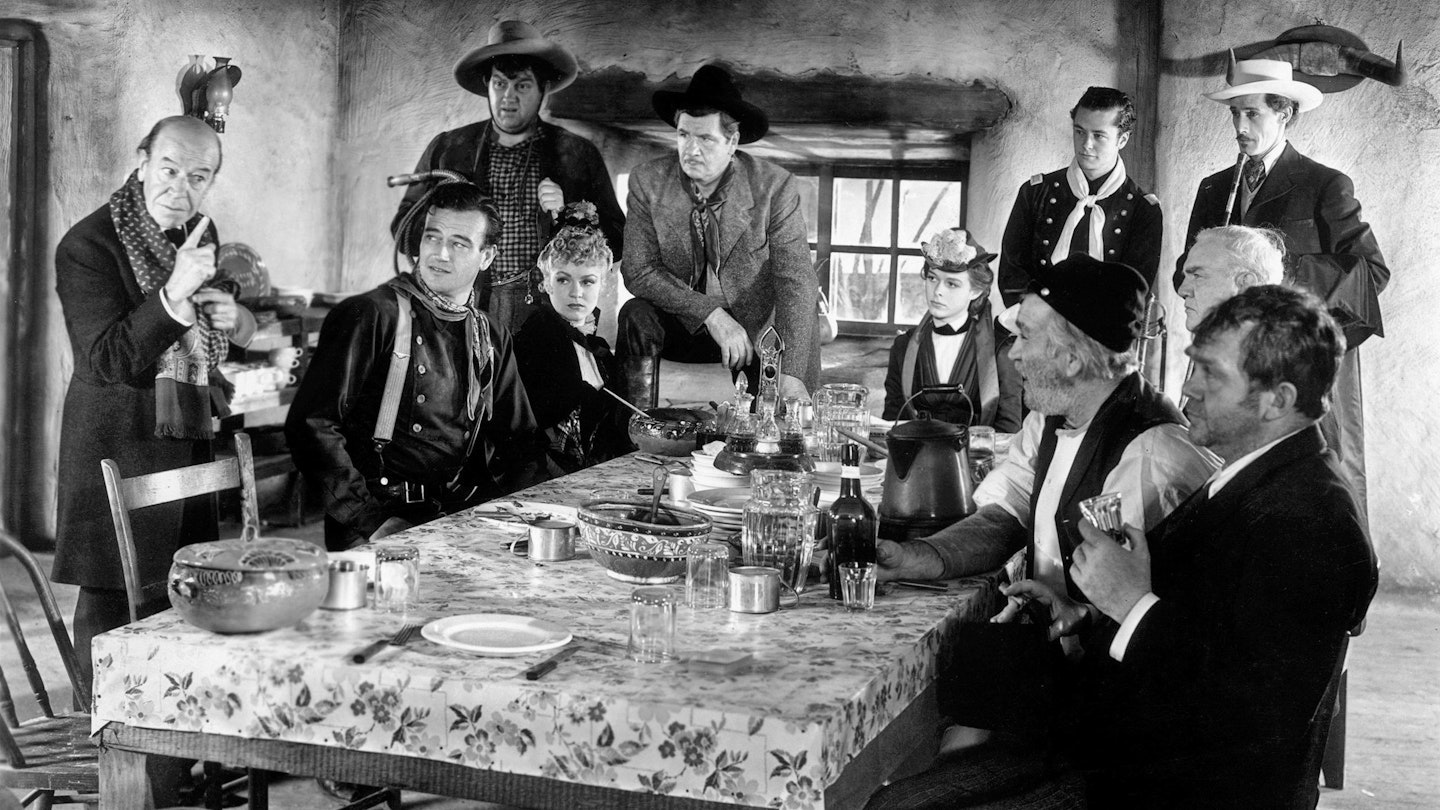It's a matter of Hollywood legend that when the producers of the 1966 remake of John Ford's immaculate western realised what a truly monstrous turkey they had on their hands, they rounded up and destroyed as many prints of the original as they could find. Ford's film only survives, apparently, because John Wayne had a personal copy locked away in his safe. In a way you can't blame them, the 66 film is so appalling that desperate measures were called for. Then again it's hard to feel much sympathy for anyone who attempts to recut a Yakima Canutt's courageous stunt fall under the galloping horse remains an incomparable piece of adrenaline-fuelled action cinema perfect gem by casting Alex Cord (later a stalwart guest-star of The Love Boat), Ann-Margret, Mike Connors and Bing Crosby in place of John Wayne, Claire Trevor, John Carradine and Thomas Mitchell.
The producers of the 1986 made-for-TV debacle, which starred Johnny Cash, June Carter Cash, Waylon Jennings, Kris Kristofferson and Willie Nelson as Doc Holiday (the Apaches were played by members of the Charlie Daniels Band just kidding!), were faced with an even greater dilemma. Their only hope lay in massacring not only prints of the original, but also anyone who was even dimly aware of its existence. If the dazzling brilliance of Ford's version of Stagecoach isn't immediately obvious, a glance at either of the above abominations should bring it into sharp focus.
All three films sport the same simple plot an odd assortment of travellers journey from A to Bs and are beset by hostile Apaches en route but it's a mark of Ford's genius that he transforms garden variety source material into a feast of characterisation, visual poetry and heart-pounding action. The screenplay, by Dudley Nichols, was based on the short story Stage To Lordsburg by Ernest Haycox. It also bears trace elements of Guy de Maupassant's Boule de Suif, and Ford further spiced things up by importing a few pungent souls from Bret Harte's dime novel classic Outcasts Of Poker Flat (which was itself the subject of four film adaptations). It proved a winning combination. Ford's first western in 13 years (he took a hiatus after Three Bad Men in 1926), Stagecoach trumpeted the master's return by taking the conventions of the genre and spinning them on their ear.
Out went the indomitable lone hero, out went the clear-cut delineation of good and evil, out went the traditional pacing of action sequences and out went the "riding into the sunset" ending. In their place, Ford substituted as strange a band of bedfellows as ever boarded the Wells Fargo. He put his hero in handcuffs, ripped up the rulebook on romance, placed the climactic action scene two thirds of the way through the film and, in the finale, had Wayne drive off into a shimmering dawn, heeding not the call of the wild, but heading instead for a life of domestic bliss.
Wayne, as Johnny Ringo, the role that made him a superstar, is the closest thing to a traditional hero on offer. But Ford puts his cards on the table early. When we first meet Ringo he's just busted out of jail and is stranded in the desert with a dead horse. A cowboy hero without a mount was an act of subversion, as was placing him in the midst of the microcosmic society inside the stagecoach. When Wayne clambers aboard he submits to arrest so he can hitch a ride to Lordsburg where he plans to kill the gunmen who murdered his family the relationships between the passengers begin to percolate. And as the stage trundles through the spectacular landscape, heading ever closer to its date with Geronimo's marauding braves, their less-than-perfect lives are laid bare. It's in these scenes that Ford really messes with the stereotypes. The woman of virtue (Platt) is actually a stone cold snob; the boozy doc (Mitchell) is a stand-up guy; the gambling man (Carradine excellent) turns out to be a gentleman after all; the self-righteous banker (Churchill) is a thief. Moreover, the vengeful outlaw and the faded whore (Wayne and Trevor) routine western coffin-fodder are the tender heart of the film.
Featuring groundbreaking editing and camerawork, some of the most daring stunt riding ever filmed and the icing on the cake Yakima Canutt's unbelievably courageous fall under the galloping horses, it is still an incomparable piece of adrenaline-fuelled action cinema.
Even Ford realised he couldn't top it, deliberately playing down Ringo's tail-end shootout with the Plummer gang. Again, a significant break with tradition. It has been noted, of course, that had the Apaches really wanted to capture the stage, all they had to do was shoot the horses. This is a quite reasonable observation, and anyone who feels compelled to make it should be punched repeatedly in the face.
